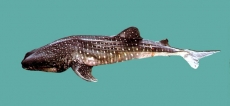|
Tags: fish | Rhincodon typus | Whale Shark
Rhincodon typus, also known as Whale Shark, inhabits inshore, offshore, and at outer parts of temperate and tropical waters. It is inclined to cruise near the surface of the water. Usually swims alone, while it is occasionally found in aggregations of up to more than 100 individuals. Usually accompanied by pelagic fish such as tuna and mackerels; also associated with remora or other small fish. Feeds on planktons, and sometimes crustaceans, small fish, and squids. Usually forages for food after sunset. The species can grow up to 20 meters, which is the largest among most fish. Found and caught usually with set nets, seine nets, or by spear fishing method in the waters of north, east, and southern Taiwan. Edible and highly commercial: can be stir-fried, salted, or mashed into a paste for fish balls. The fins are usually dried as a delicacy and the oily livers can be used to produce vitamins or liver oil. IUCN (International Union of Conservation of Nature) status: vulnerable A1bd+2d, June 30, 2000; classified by IUCN as category two endangered species. Considered the biggest fish, the species is very popular in aquariums, as a symbol of ocean conservation and for its importance to ecotourism. In addition, fishing whale sharks has been banned in Taiwan since 2008, yet it is still necessary to enhance this policy through promotion and education. (Archived by Biodiversity Research Center, Academia Sinica)

Biodiversity Research Center
|












